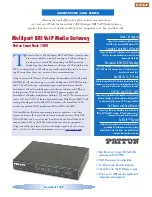
User Guide
T1/E1 configuration guide
33
12.3.3. Signaling Setup
Signaling is a protocol to exchange information needed for line monitoring, call setup or
release between exchange equipments, between extension line and exchange equipment,
or between network equipments.
Digital trunk has two types of signaling as below.
- Common Channel Signaling (CCS)
- Channel Associated Signaling (CAS)
Command for signaling setup is executed in the directory of ‘MAX:/CONFIG/DTRUNK>’.
MAX:/CONFIG/DTRUNK>change cfg sig <value>
The option value can be selected as ‘
R2
’, ‘
DTMF
’, or ‘
ISDN
’.
‘
R2
’ and ‘
DTMF
’ are CAS signaling type and ‘
ISDN
’ is CCS signaling type.
12.3.4. CCS
CCS is a signaling type used to send signaling information as out-band signal.
The most notable and widely used form of this signaling type is ISDN. One
disadvantage to using an ISDN primary rate interface (PRI) is the removal of one DS0,
or voice channel in this case, for signaling use. Therefore, one T1 may have 23 DSOs,
or B channels for user data, and one DSO, or D channel for signaling. It is possible to
control multiple PRIs with a single D channel each using Non Facility Associated
Signaling (NFAS), and therefore, you can configure the other PRI's in the NFAS group
to use all 24 DS0s as B channels
MAXN supports T1 ISDN PRI and E1 ISDN PRI.
T1 ISDN PRI or E1 ISDN PRI depends upon digital trunk type.
12.3.5. ISDN PRI
The commands and parameters used for ISDN PRI setup are as follows:
promode
– ISDN protocol mode
This parameter is used to set ISDN protocol mode. (ETSI, National ISDN-2)
This setting must be identical to that of the counterpart PBX and support
MAX:/CONFIG/ISDN>change promode <value>
















































